Disclaimer: Skylead is not affiliated, endorsed by, or connected with LinkedIn in any way.
According to the ManpowerGroup survey from Q3 2021, 69% of companies and talent acquisition specialists around the globe reported talent shortage. Moreover, according to Officevibe*, some top candidates have a 10-day window before landing a job.
Now, with the short time frame and a small pool to pick highly-qualified candidates from, talent acquisition specialists are in a difficult position. If they wish to hire the best employees, that is. This is more than enough reason to roll your sleeves and research talent acquisition and how to ace it.
So, if you wish to help your company, and find the best talent out there, then get ready for the jolly ride. We will uncover everything there is to know about talent acquisition and reveal tips to help you hire the best talent out there.

What is talent acquisition?
Talent acquisition is a process of recognizing and gathering the top employees for the company. In other words, talent acquisition means finding and nurturing the right employees according to the company’s needs.
The importance of talent acquisition has become evident to companies all over the globe, regardless the size. The reason is that talent acquisition specialists:
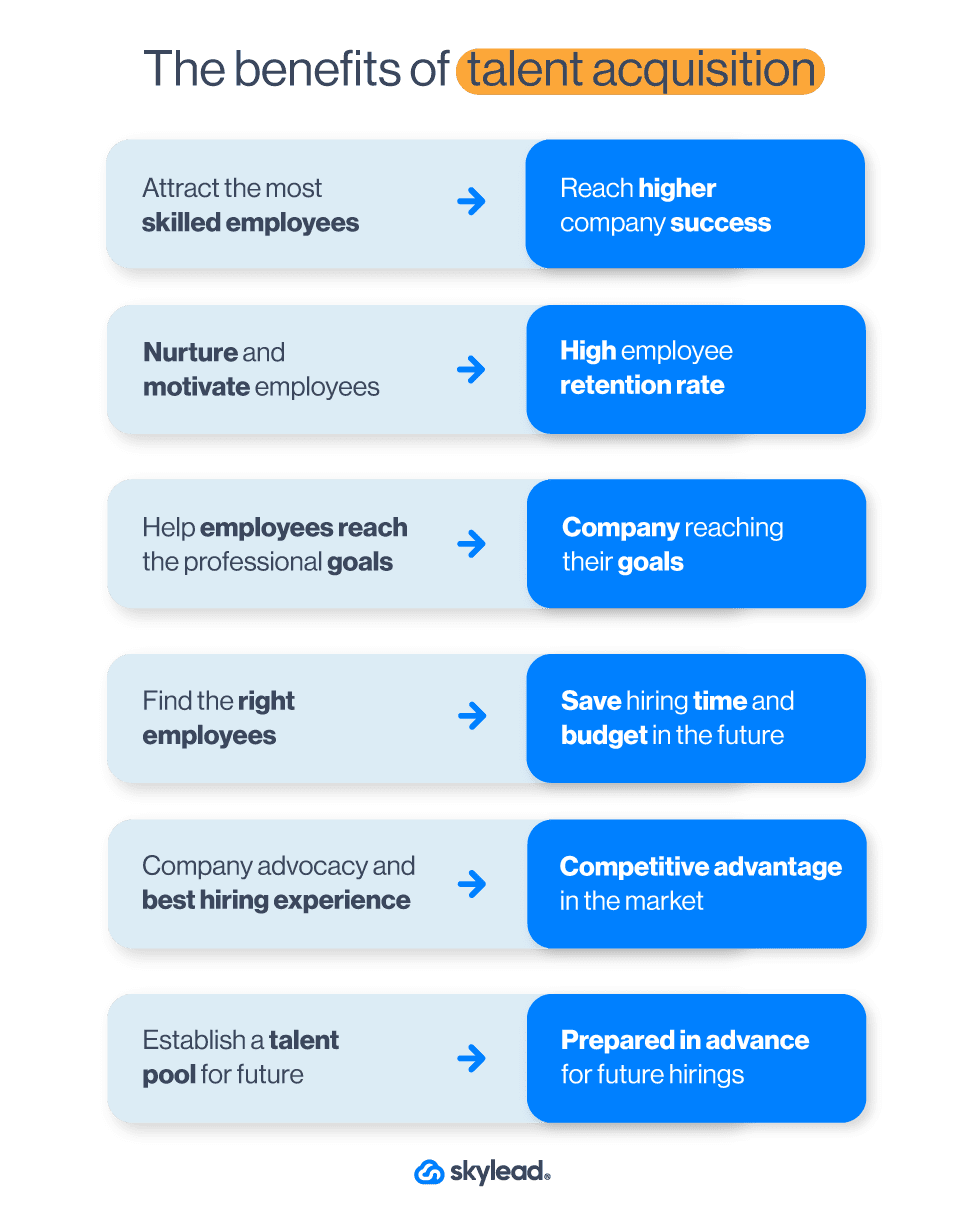
- Attract the most skilled employees on the market to fill the key roles according to company culture and strategy. This ultimately leads to the company’s improvement and reaching the desired results;
- Nurture and keep employees motivated, which leads to high retention rates and company advocacy;
- Develop and provide education to help employees reach their professional goals;
- Find the right employees and therefore save hiring time and money in the long run;
- Are advocates for the company and provide the best hiring experience, thus creating a competitive advantage in the labor market;
- Establish a talent pool for future hires, thus being prepared in advance.
And we just named a few 🙂
Recruiting and talent acquisition are often mistaken for one another. Yet, these two are the different sides of the same coin. Moreover, talent acquisition and recruiting may or may not be a part of the same sector. However, they are closely tied and cannot work without one another, which will cover in a second.
Talent acquisition VS recruitment
What is the Difference Between Recruitment and Talent Acquisition?
Talent acquisition is much more than just recruiting. It is a strategy on how a company should present itself in the labor market and become an ideal place to work in. Furthermore, the talent acquisition team is responsible for everything talent-related, including but not limited to:
- how to source the talent;
- supervise hiring;
- hire themselves in some cases;
- identify future leaders for the organization;
- lastly, they are responsible for screening candidates for leadership positions and the ones who need diversified training.
As opposed to the strategy, recruiting is the sole action of filling job vacancies and short-term company hiring requirements. In other words, recruiters:
- Find candidates or screen job applications;
- Interview candidates;
- Evaluate and select;
- Hire candidates.
What is a talent acquisition specialist and what do they need for a job well done?
So what does the talent acquisition specialist need to have for the job? First, they need to have a psychology background and to know their way around people. Secondly, they also need to know how to nourish relationships inside and outside the company. Thirdly, they need to keep employer branding at the highest level.
Another thing someone needs to have is strategic thinking and the ability to know what the company needs or will need in the future.
As their job is to find top talents, talent acquisition specialists need to know how to do their research. Moreover, they need to know how to track job search impulses, set candidate alerts, and find perfect candidates for the job at the right time.
Lastly, it is always handy to have a set of sales skills for interviewing top-tier candidates. To clarify, the sales skills will help you get the employee that does not necessarily wish to change their job but would be just perfect for the role.
Process of talent acquisition
Talent acquisition includes the following stages:
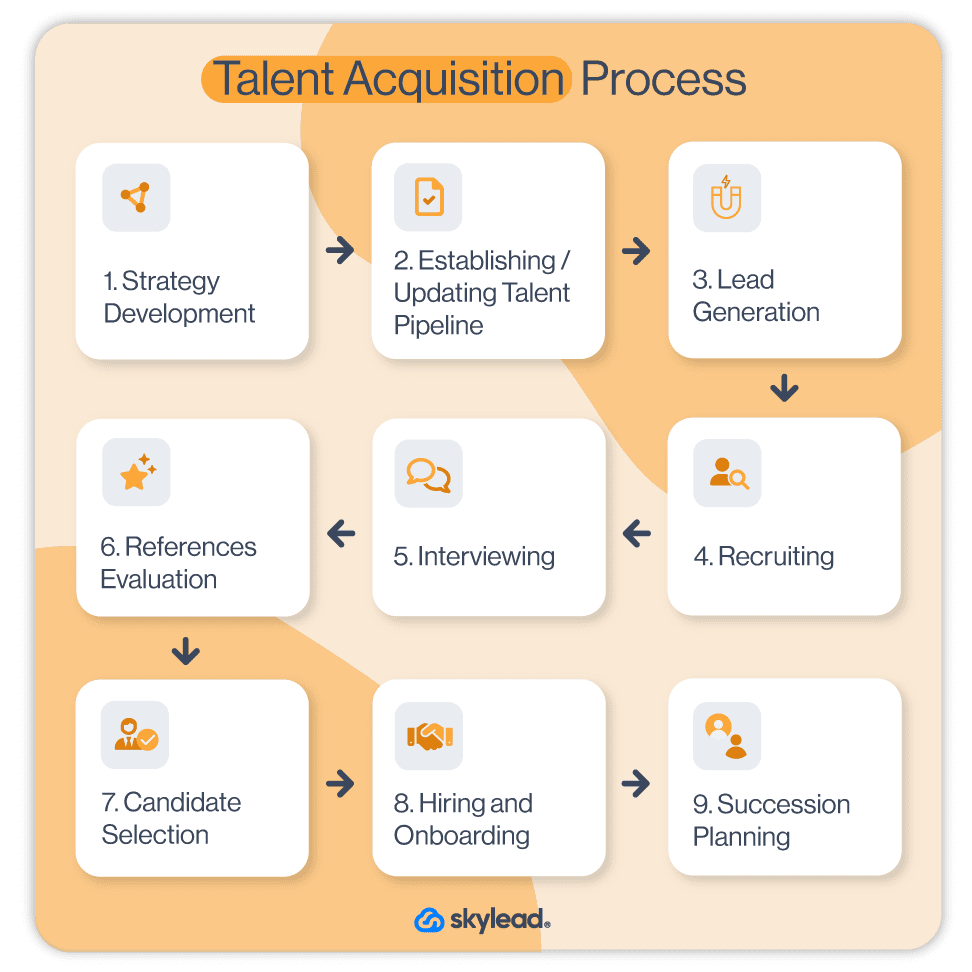
- Strategy Development
- Establishing/Updating Talent Pipeline
- Lead Generation
- Recruiting
- Interviewing
- References Evaluation
- Candidate Selection
- Hiring ( and Onboarding)
- Succession Planning
Let’s get into the details with every one of these activities.
1. Talent acquisition strategy development
Before developing any talent acquisition strategy, one must first define:
- The company’s position in the market;
- Budget available for talent acquisition activities;
- Who the competitors are;
- Competitors’ labor market behavior and their funding (if available).
Once you establish the previously mentioned, you can use that information to plan your strategy carefully.
There are two types of strategies that go hand in hand:
- Employer branding strategy
- Talent finding and acquiring strategy
The strategies can be any combination of activities. Participate in job fairs and universities, boost your employer's brand awareness and gather early talents, or referral programs, sponsor job fairs, and even outsource some parts of the process to RPO companies, for example. Only, whatever you decide your strategies are, be detailed, organized and mindful of your company’s industry, needs, and the budget.
2. Establishing talent acquisition pipeline
As talent acquisition strategy depends on talent pipelines, you need to create a mechanism to keep them full at all times. If your talent flow for every position in your company is continuous, you will always have someone to pick and choose from, should the need arise.
Otherwise, you need to discover what makes your pipeline “leaky” so you do not waste additional resources to fix the damage every time.
3. Lead generation
Once you have your strategies and talent pool in place, you need to define the online (and offline) channels you will use to find and generate your leads, aka candidates. Next, you need to write an alluring job post and an application form to start filtering out and identifying the best candidates. Lastly, distribute them across defined channels and according to your strategy.
4. Recruiting
If your company doesn’t have a separate recruiting sector, get ready to roll your sleeves. Recruiting is much more than just interviewing the candidates and choosing the right talent. Remember, they are also choosing you.
So apart from standard recruiting and evaluating the applications that landed in your inbox, you need to do something extra. Firstly, establish ways to create a positive experience for your candidates. Secondly, nurture them throughout the process. Lastly, keep the relationship with those who are not currently your ideal match but someday they might be.
5. Interviewing
This is where your psychological background and sales skills really shine. When interviewing the candidates, talent acquisition specialist should ask a series of questions related to:
- the candidate's specialty;
- problem-solving skills;
- resourcefulness.
And not to forget, they need to figure out if the candidate has skills for any current or future positions.
Interviewing is usually held between 2 to 4 instances, depending on position seniority. However, talent acquisition specialists are trying to shorten the number of instances to provide as pleasurable an experience as possible.
6. References evaluation
Talent acquisition specialists often forget to cross-reference the information their candidates provide during the interview. Reference evaluating can provide another perspective on your candidate, confirm your thoughts and opinions, or provide additional information you wouldn’t find anywhere else.
7. Candidate selection
Talent acquisition specialists and recruiters lean on many metrics and systems to make data-driven decisions and select the top candidate for the job. Some of them include candidate scoring, internal evaluating systems, and even software that can do that for them. So be sure to research these systems and choose one which works best for both you and your company.
8. Hiring and onboarding
In some companies, talent acquisition teams also onboard new employees. Thus, apart from showing them around the office, or workflow, talent acquisition specialists are responsible for establishing new relationships. That said, incorporating efficient Applicant Tracking Systems (ATS) can greatly facilitate talent acquisition specialists in streamlining the onboarding process, ensuring new hires are integrated smoothly into the company's ecosystem.
9. Succession planning
The last activity that talent acquisition specialists need to do is succession planning. a process of identifying and finding substitute candidates for the leadership roles within the company in case something unexpected should happen or in case of retirement.
Succession planning is beneficial due to several reasons. Firstly, the company is always ready for any unexpected events. Secondly, it encourages employee development within the organization. Lastly, succession planning allows filling the roles quickly without losing much of the workflow.
15 Tips and best-case practices to improve talent acquisition activities
1. Minimum requirements
When creating a job description, it’s best to define the minimum and the maximum requirements someone needs to have to be qualified for the initial interview. To clarify, the reason for the minimum requirements is that you might meet someone who doesn’t have the highest experience you need, but they might have it in the future.
This means you can put them straight into your talent pool and contact them at a later stage. Or perhaps the person with less experience is a perfect match according to other company parameters (e.g. cultural, behavioral), as opposed to the one with the maximum requirements.
2. Collaborate with other sectors
Every sector and job position within the company has its specialties and expressions different from what the talent acquisition team uses. It’s okay not to know them all, as long as you keep collaborating with the rest of the company during the previously mentioned process for individual positions.
3. Write job post that is alluring
With each vacancy comes a special job description. So, be aware of what kind of talent you wish to draw to your company and write job posts to appeal to them. Spice it up with some benefits, perks, and employer branding testimonies, and you’ll be good to go for initial lead generation.
4. Remote or hybrid workspace
To stay competitive in the labor market, you must keep up with the trends. And one of the most popular trends now is precisely Remote or Hybrid workspace. Be mindful of this, and if your company doesn’t offer a fully remote position, at least offer a hybrid position, so you don’t lose top talents over this.
5. Where to build a pipeline?
Different talent acquisition teams use different platforms to help them build their talent pipeline and keep track of the candidates. That said, the most widely used is LinkedIn Recruiter or Recruiter Lite, which allows you to get candidates inside the pipeline with just one click and to the appropriate pipeline stage.

6. Include your co-workers in the process
It’s nifty to discover alternative ways to find and generate your candidates. However, remember that you, as a talent acquisition specialist, are not alone in your company. Thus, think about creating a referral program for your employees.
Your co-workers are the next best thing to know what kind of personnel your company needs, and if you set proper awards, you are more likely to find the right candidates quicker. After all, there is a “Six degrees of separation*” theory stating that any person can be connected to any other person in the world through six intermediaries at most.
7. Don’t rush
Finding the right employee is not an easy task, especially if we talk about C-suite positions. Thus, take your time and do not rush any activity. If you are thorough and dedicate time to each part of the talent acquisition process, you will save resources in the future.
For example, most talent acquisition specialists use LinkedIn Recruiter, and the one thing they never rush is filtering the right candidates for the job. Thus, take advantage of every LinkedIn Recruiter filter and take your time zeroing in on the candidates you will reach out to.
8. Research your candidates
If, for example, you use LinkedIn to find candidates, you should consider the following advice.
Firstly, to laser-target your candidates, be sure to specify your search as much as possible. In other words, use filters to import the most relevant skills needed for the role.
Secondly, when looking at LinkedIn profiles, observe the diversity of interests a person has. The information you find will contribute to your company and imply what you need to do to achieve employee satisfaction.
Thirdly, if you are searching for the people to fill in higher-up roles, be sure to analyze the skills they possess that served them in the previous positions that can be usable for the one you are reaching out to.
Lastly, if, for example, you're searching for a team leader for your programming team, you might consider how the team could contribute to the team leader’s development.
9. Streamline a part of your talent acquisition process
If you headhunt using LinkedIn Recruiter, then you must’ve experienced how tiresome it is to reach out to every person on the list manually. Luckily, you don’t have to. You can streamline your outreach process by getting a solution to do it for you and thus save so much time.
Take Skylead, for example. You can create an outreach campaign quickly and easily. Firstly, take your LinkedIn Recruiter pipeline or talent pool URL with all the candidates you found by prospecting on LinkedIn.
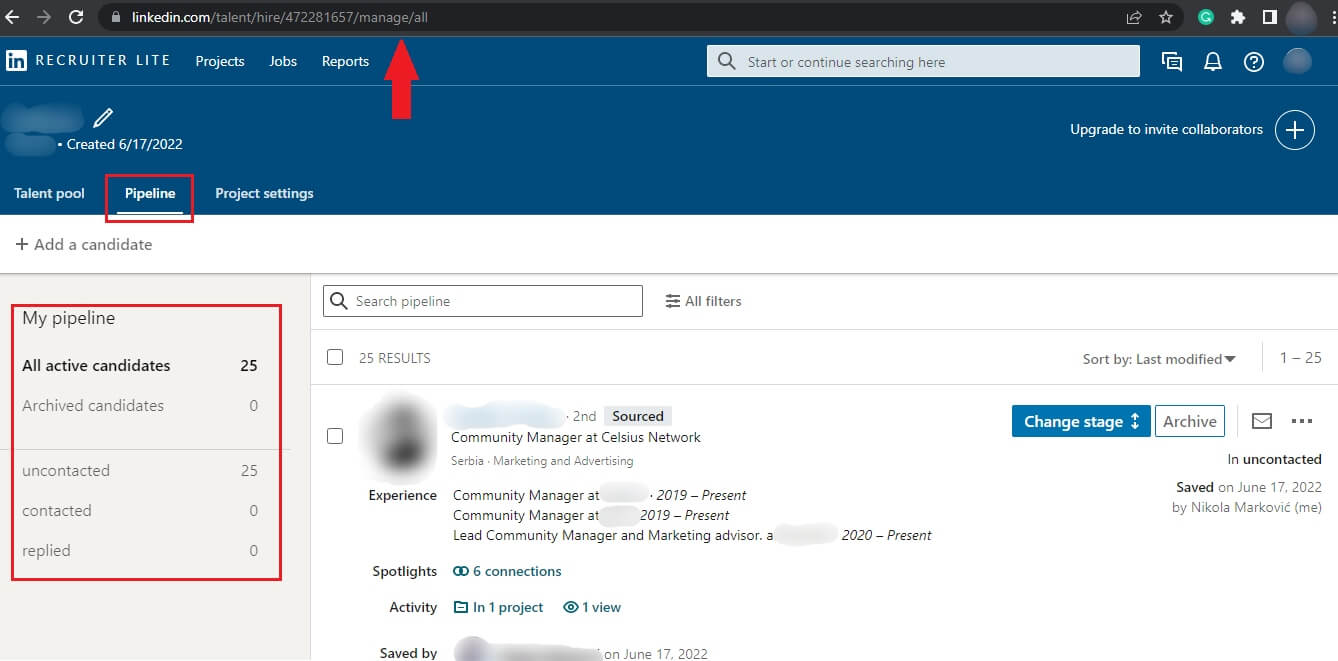
Then, go to Skylead and paste it into the respective field. Be sure to name your campaign, and select the type of campaign.
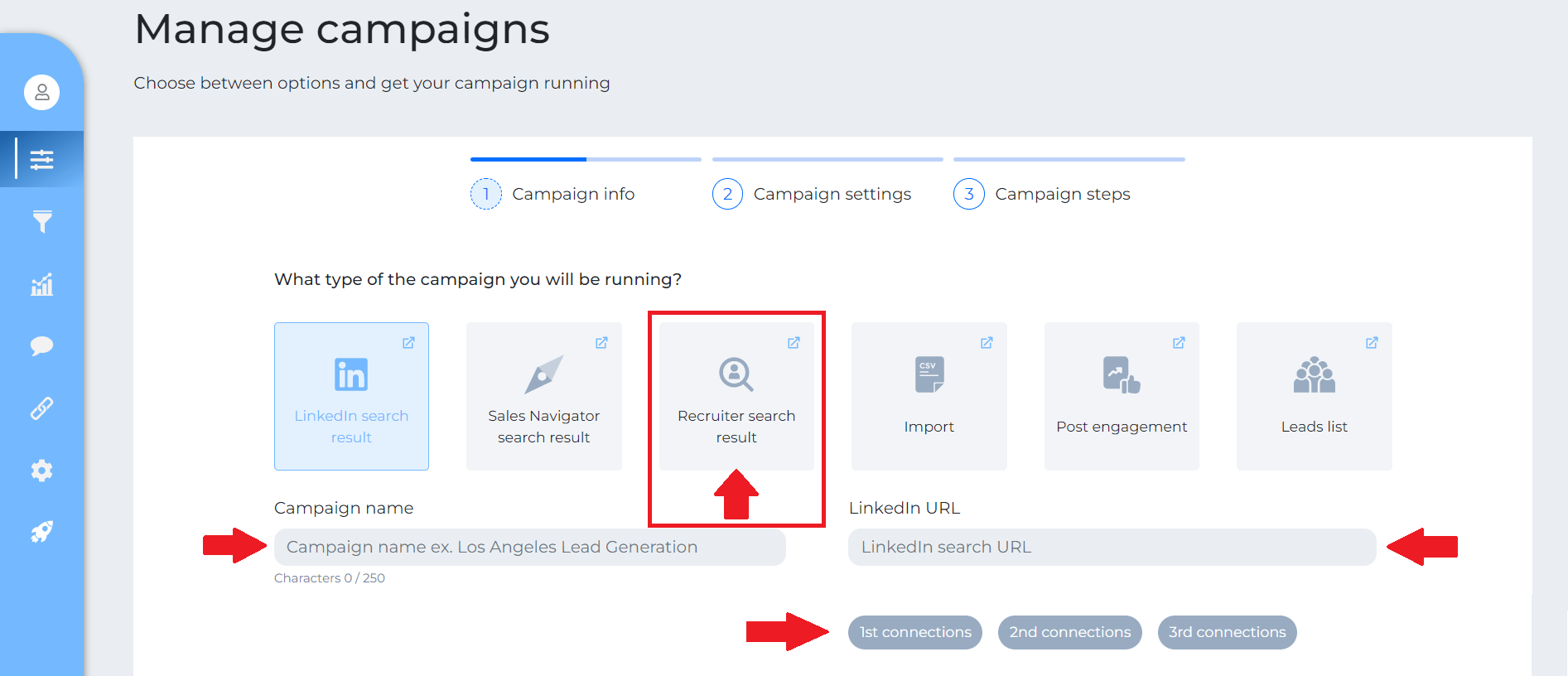
Next, create your Smart Sequence steps and your messages. To clarify, Smart Sequences are Skylead’s groundbreaking algorithms. They allow you to use multichannel outreach and personalization at scale.
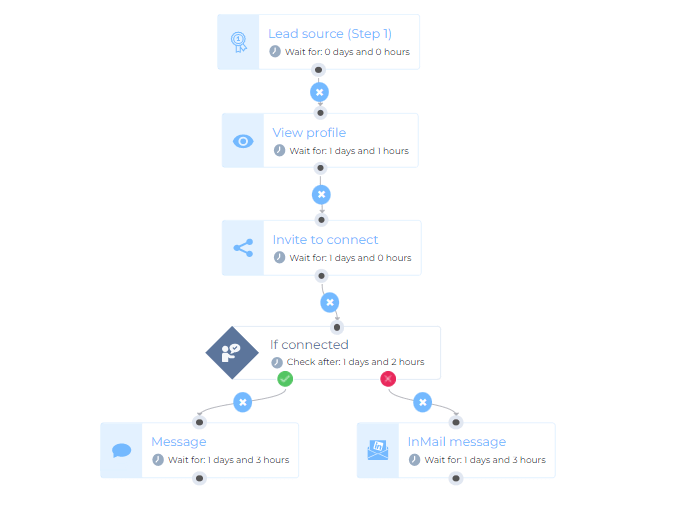
And you are done!It is that simple.
Skylead can also help you schedule your interviews from the Smart Inbox, so there is no need to navigate between the platforms.
10. Personalize your messages
Nobody likes getting generic emails, nor will your ideal candidates for the top-level job. Thus, to provide the best experience for your candidates, make sure to personalize your outreach according to their resume or LinkedIn profile. For example, include their name, position, or the skills that stood out to you the most.
11. Don’t forget to proofread
Typos, wrong names, and grammatical errors in your email can come across as unprofessional and can put your company in a bad light. So, to avoid this, edit, proofread your messages, and double-check contact information for any mistakes before sending.
12. Timing is everything
Good timing is a desired virtue for talent acquisition specialists to have. Timing to recognize and outreach candidates at just the right time according to their job search impulses.
However, there is one other timing equally if not more important than that - responding to your candidates on time. If you wait too long, especially if you hire management roles, you risk losing your candidate’s interest and someone else taking them over.
13. Choose your questions carefully
Sometimes the candidates won’t be as direct as you would like them to be. So, to get the information, you need to get creative during the conversation. The best-case approach here is to ask so-called probing questions to specify their response. In other words, you can ask them a series of questions like:
- Tell me, how did you manage a group of people to achieve the best productivity throughout the day?
- What objectives did you set for the group?
- How did you motivate them?
- What was the most difficult part of this task?
In addition, take note of what the candidate asks you in return, how they prioritize their interest for the role, and what they are curious about the company (benefits, conditions, market share, organization culture, etc.).
14. How should talent acquisition team choose the best candidate?
Selecting the right candidate for the job can be a hard decision for a talent acquisition specialist. If you are lucky, you can pinpoint the person you wish for your organization. However, what to do if you have two or more top talents in your hand?
Hire them all 🙂
Jokes aside, here is what you can do to ease your decision.
The first thing you need to pay attention to is authenticity and synchronicity between the candidate's personal preferences and the information you get from the interview. In other words, analyze verbal and non-verbal communication, and the thought process and write your observation down.
The other thing you can also do is to walk the candidates through questions about personal preferences of informal, trivial topics and get to the main questions later. Using this method, the candidate could reveal themselves through potential incoherence.
Once you have all data in place, choose the candidate with the smallest amount of discrepancy and highest compatibility.
15. Honesty is the best talent acquisition strategy
Somehow in the business world, we always come back to honesty, and talent acquisition is no exception. I mean, have you heard about Microsoft’s promise to disclose salary ranges in January 2023?
Many talent acquisition specialists are true advocates for honesty, and there are major reasons for that. Firstly, it adds to the authenticity. Talent acquisition specialists often share why they work in a particular company, their motives, and what motivates them the most to be where they are. This way, candidates can see the true passion in the conversation and wish to work in that company, as well.
Talent acquisition specialists and recruiters thus act as a live banner of the company. If the candidates do not resonate with the passion, it’s best to reveal it from the start - it will save you so much time in the future.
So, keep in mind that being honest and believing in your company is one of the best things you need to show to your candidates. Not only will you filter and acquire the best candidates, but you will also contribute to the Employer branding strategy.
Lastly, your honesty and passion will be such a strong argument that negotiations and whether someone wishes to work for the company won’t even be a question anymore.
Summary
Talent acquisition and the labor market are one of the most changed segments due to technological development in the last couple of years. Apart from company Goodwill, talent acquisition sectors are the ones that represent a company directly to the outside world.
Speaking from the company’s point of view, it pretty much became a standard to have talent acquisition specialists simply because of all the benefits it comes along: from resource savings to reaching higher goals by finding a perfect match and employee satisfaction.
However, none of it comes without the talent acquisition team’s hard work and activities that involve:
- Strategy Development
- Establishing/Updating Talent Pipeline
- Lead Generation
- Recruiting
- Interviewing
- References Evaluation
- Candidate Selection
- Hiring ( and Onboarding)
- Succession Planning
And let’s not forget that our trusted talent acquisition specialists are go-to guys for everyone in the company. They are somewhat of our genie in the bottle for professional development.
Nonetheless, talent acquisition specialists can perfect their craft by following the tips and best-case practices mentioned above. Lastly, people are dynamic, so if you, as a talent acquisition specialist, help others develop their talents, don’t forget about yourself.
Wish to discover how to streamline your talent acquisition process? Check out Skylead and schedule a Demo!
Disclaimer: Skylead is not affiliated, endorsed by, or connected with LinkedIn in any way.
What is the real difference among LinkedIn Recruiter, Recruiter Lite and Premium Business?
Finding the right employee can be a tough job. More so, if you use a more traditional hiring method, such as job posting websites. We don’t say that these methods don’t work. However, they require a ton of effort and time to comb through applicants’ skills and experience.
Besides, the time spent going through these applications can lead to the prolonged time needed for hiring. Undoubtedly, for businesses, this means an extended period without employees and work to be done, aka money loss.
That is where LinkedIn jumps in. Many HR professionals swear by this as the world’s most popular professional network. More so than any other platform out there. Thus, LinkedIn created a separate platform for all the HR professionals where they can do their LinkedIn prospecting and outreaching - Recruiter.
However, is the LinkedIn Recruiter really the best LinkedIn subscription for HRs? Or can the same job be done with Premium or LinkedIn Recruiter Lite? Let’s be the judge of that together, shall we?
Today, we are covering what LinkedIn Subscription options exist for hiring managers, their pros and cons, and what you should consider when choosing the right type of platform.
LinkedIn Premium Business subscription
This LinkedIn subscription is, first and foremost, created for individuals who wish to boost their skills, connect with like-minded people or companies, and extend their network. It offers many features that a free LinkedIn account does not. And it is a decent upgrade if you wish to step up your LinkedIn game in any way you can imagine - be it for sales, networking, or job-seeking efforts.
Who is it for?
Premium LinkedIn subscription is a good tool for any job seeker, business leader, or entry-level sales manager. Even though the LinkedIn Premium Business plan is not for hiring managers specifically, it can do a nice job with posting jobs and reaching out to your candidates. Here’s how.
LinkedIn Premium pros
Unlimited people-browsing
If you have a basic LinkedIn account, you will notice that you can have up to 10 unlimited searches a month.
However, as a Premium Business subscriber, you will have unlimited searches for profiles up to the 3rd-degree connection type. This way, you can search and connect to the right candidates faster.
Free job posting
You can post a job free of charge using the LinkedIn Premium subscription. Apart from the job description, It gives you additional options to fill in, including screening questions and skills required.
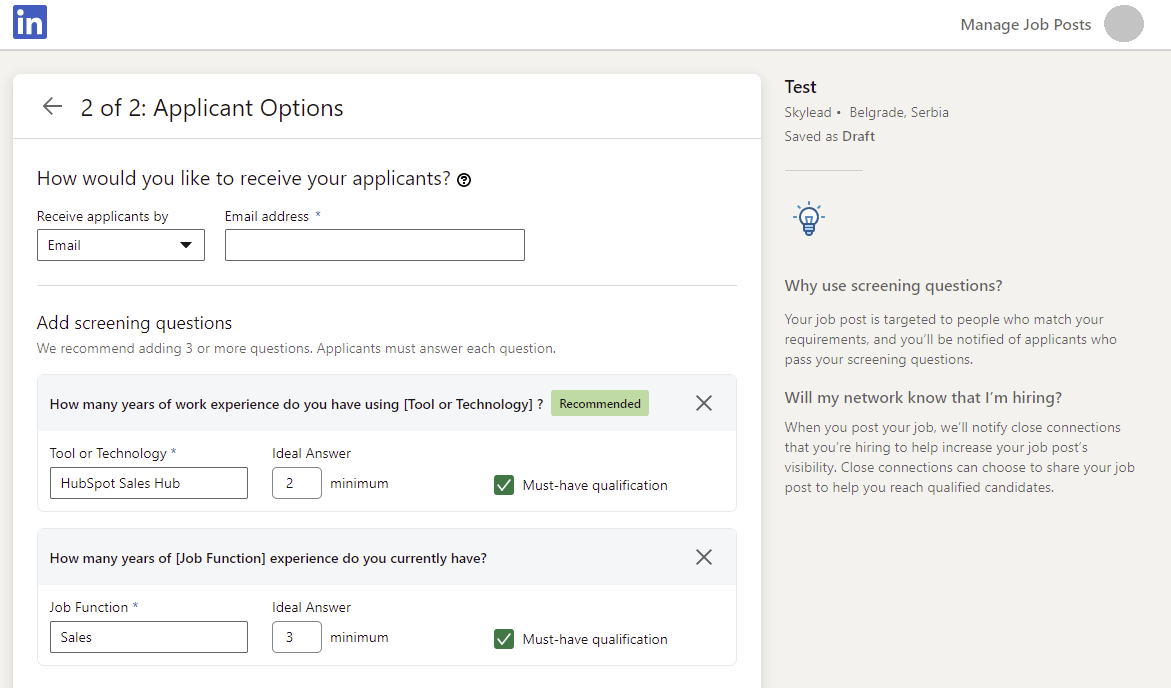
The good thing about this process is that LinkedIn offers an option to reject candidates and send them a predefined message automatically, which saves you a lot of time. However, it lacks personalization.
After you publish a job post, LinkedIn will show it only to your network. Yet, if you want your job to be more visible, you need to pay to promote it. To clarify, you determine the budget you wish to invest, and LinkedIn only spends it when someone clicks on your job post.
If you decide to promote it, LinkedIn will publish your job ad on certain LinkedIn pages or via email and push notifications to find you the best candidates. Otherwise, LinkedIn will notify your connections that you’re hiring. Consequently, your network can help increase posts’ visibility by sharing. Thus you can reach qualified candidates easier.
InMail credits
If you are looking for a specific person that ends up being outside of your network, nor do you share a group with them, LinkedIn will provide you with an option to reach them out by using InMail. Check out our complete guide on how LinkedIn InMail works.
InMails, aka LinkedIn emails, can be useful when you want to reach out to potential employees you think are the best fit for the job. Also, they are good when you do not wish to risk getting your email in a spam folder or do not have the email address, to begin with.
Unlike LinkedIn basic accounts, Premium Business offers 15 InMail credits a month. It’s not a lot, as other subscription plans provide much more. Still, it is more than enough for small to medium-size companies that do not have frequent hiring or headhunting needs.
Furthermore, LinkedIn will return you the InMail credits you spent if you receive a response. And if you need inspiration for your outreach, check out our InMail templates.
Finally, LinkedIn allows you to gather InMails. In other words, if you haven’t used InMails over the course of 3 months, you can have up to 45 InMails in stock. However, that is the limit, and you cannot accumulate more than 45 InMails over a longer period.
“Who's Viewed Your Profile” feature
If you are a Premium Business subscriber, you will be able to see everyone who viewed your profile. You will be able to see information such as their job title and how they found you. If they have an open profile, that is. This feature is valuable for your HR persona as the potential best employees might find you first.
Company insights
Sometimes, the hiring competition is high, and job positions are undersaturated. Thus, you can use a Premium Business subscription to access competitive intelligence and an inside look at companies, their hiring trends, and current employees. In other words, you will be able to see:
- Companies’ growth rate over 2 years;
- The number of employees and hiring trends in the last 2 years;
- Employee retention.
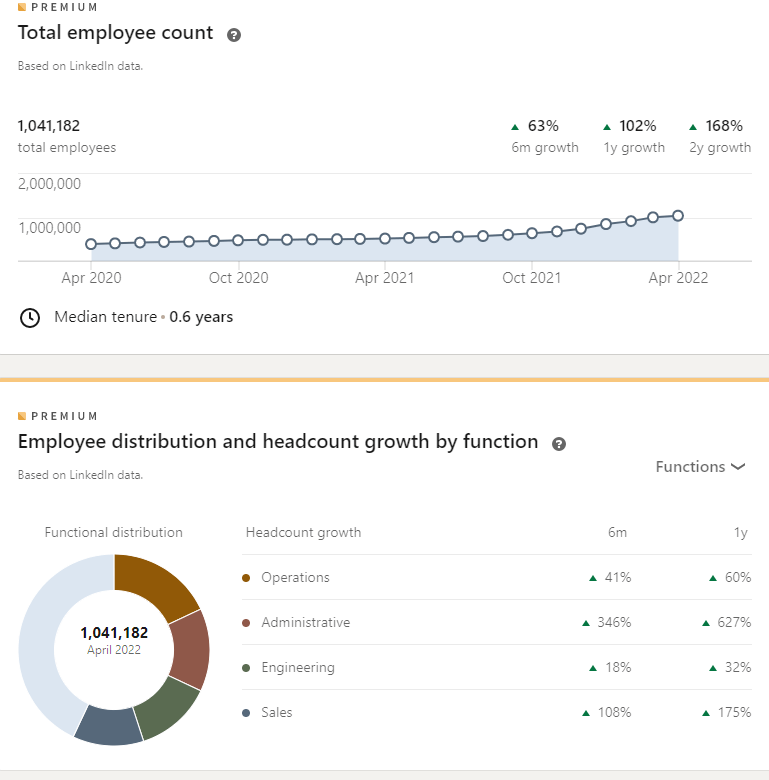
Multi-language courses
As one of its main features, LinkedIn Premium business offers a wide range of courses that any professional can complete and master various skills - over 16.000, to be precise. Furthermore, these courses are led by different industry experts, and some of them provide completion certificates.
In addition, the completed courses are listed on each user profile. So, as a hiring manager, if you are interested in pumping up your skills, you can do so in a blink of an eye and see which candidate did the same.
LinkedIn Premium Business cons
If we talk only about recruiting needs, this LinkedIn subscription plan has some constraints that do not exist in other plans.
Firstly, if you decide to find and reach out to the candidates yourself, Premium Business doesn’t have much to offer in terms of search filters. With only 11 filters available, you will be able to search candidates only by:
- Type of connections;
- Connection of the specific person in your network;
- Location;
- Current company;
- Past company;
- School;
- Industry;
- Profile language;
- Open to option for pro bono consulting/volunteering and joining a non-profit board;
- Service categories;
- Keywords, such as name, title, and company.
In addition, this LinkedIn subscription plan does not support advanced search filters, like Years of experience or Skills filters. After all, such filters are crucial for recruiters. Moreover, you do not have the Smart suggestions or search options. Thus the Boolean search option becomes quite limited. In other words, you won’t be able to search for the long Boolean strings, or the same strings won’t work as they would in LinkedIn Recruiter.
Secondly, if you wish to check your candidate's status, you will not be able to, as Premium Business doesn’t support candidates’ pipelines or job projects. To explain - a project is a workspace that LinkedIn created for its Recruiter subscriptions. They are used to track candidates throughout the hiring process, making it a nifty feature for HRs.
Moreover, LinkedIn Premium Business has no candidates recommendation option, nor does it offer to save candidate search and alerts.
How much does Linkedin Premium cost?
LinkedIn Premium Business subscription costs $60.47 per month + VAT as specified by your country. If you wish to pay annually, you will have 20% off, making the total price $579.81 + VAT yearly.
Do not forget the additional budget cost if you wish to sponsor a job post to reach a wider audience.
Is Linkedin Premium worth it?
Overall this LinkedIn subscription is useful for any professional, including hiring managers who are just starting or have low-volume hiring needs.
You will undoubtedly get your money's worth with courses, company insight, InMails, and free job posts. However, if you require more filters, candidates pipeline, templates, and access to a wider audience, you might want to reconsider upgrading to the LinkedIn subscription plans below.
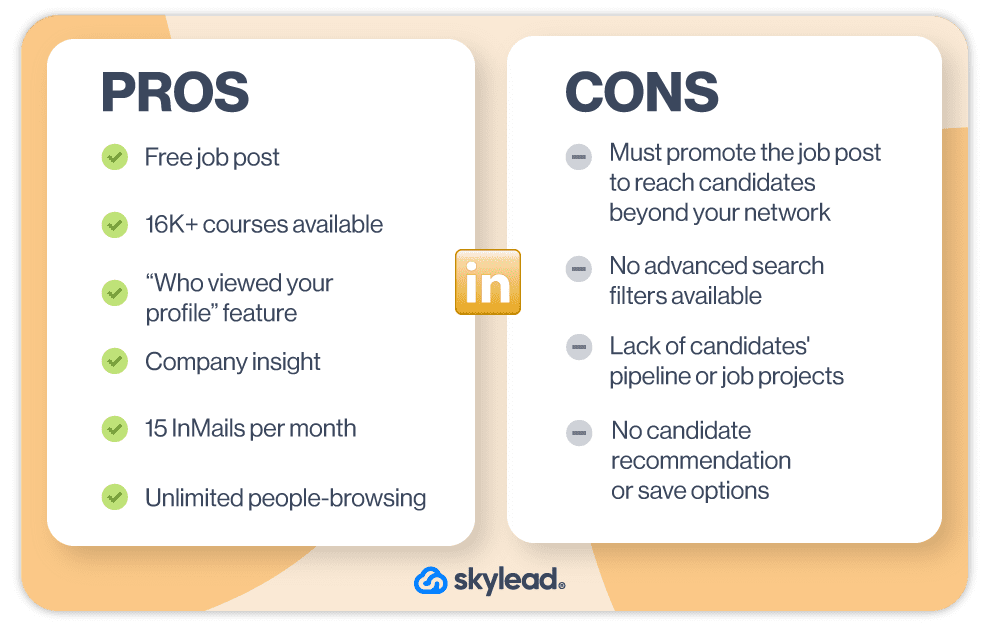
Did you know that you can use Premium plans for free? Check out our article to find out 6 ways to get LinkedIn Premium free of charge.
Recruiter Lite LinkedIn subscription
The LinkedIn Recruiter Lite subscription serves as a downgraded version of the LinkedIn Recruiter. However, downgraded doesn’t mean bad. It is more than a decent tool for hiring managers who wish to connect with a more narrow candidate group and manage candidates’ pipelines and job projects.
In addition, LinkedIn Recruiter Lite supports every feature found in Premium Business and more.
LinkedIn Recruiter Lite - Who is it for?
LinkedIn Recruiter Lite is best for any hiring manager with medium-size businesses and small-to-medium hiring needs.
Recruiter Lite pros
Managing projects
This LinkedIn subscription offers the option to manage your job posts and candidates into projects. In other words, projects are categorization tools that HRs use to organize candidate profiles into folders to review them, check their status and push them into the pipeline.
In addition, Recruiter Lite has a limit on the number of projects you wish to create, as it's a single-account dashboard. To clarify, you can create up to 100 projects at once.
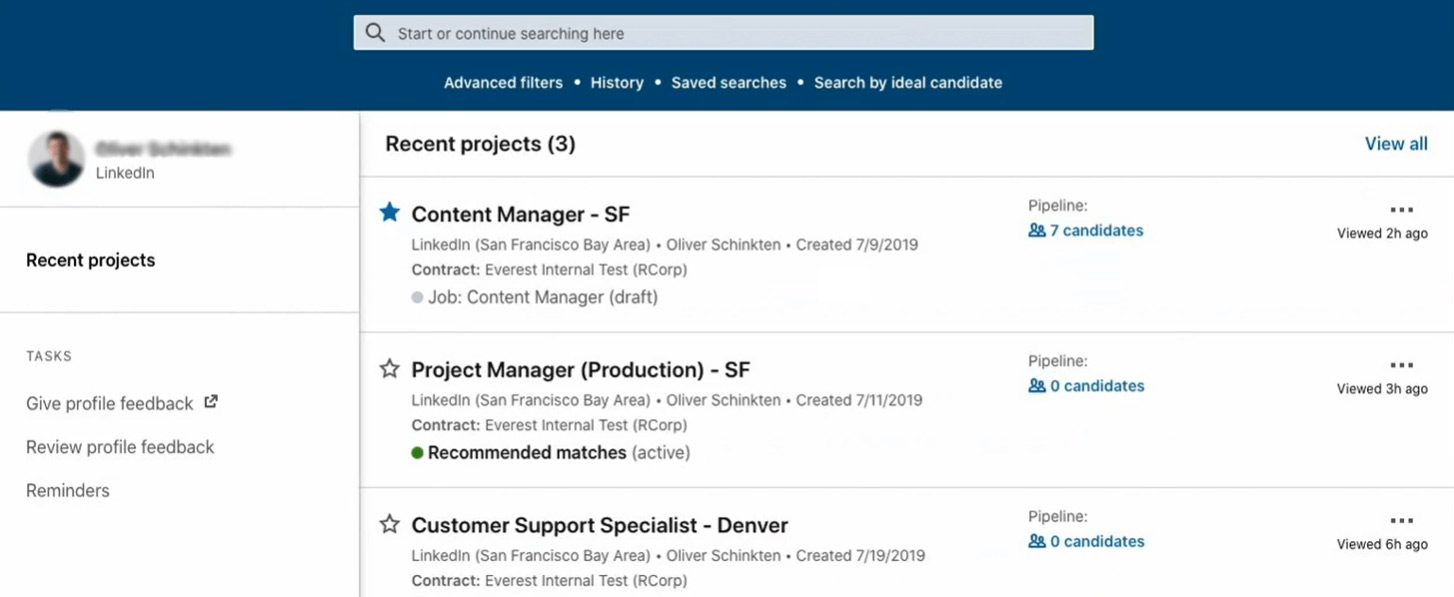
Advanced search filters
Unlike the previous LinkedIn subscription, Recruiter Lite has a list of advanced filters which you can use to narrow down your candidates’ search. So you can find the right talent by using 23 different Recruiter Lite search filters.
However, LinkedIn doesn’t have that much-advanced filtering capability as opposed to Sales Navigator filters or Recruiter itself.
Saved search alerts
Recruiter Lite has a nifty feature that allows you to be among the first recruiters to know when a certain candidate changes their job status.
In other words, search alerts included in this LinkedIn subscription will track changes in the candidates' profile, saved in your talent pool. If a candidate changes their profile status to Open To New Roles, LinkedIn will notify you, thus helping you to get ahead of your recruiter competitors.
In addition, Recruiter Lite subscribers can have a maximum of 10 saved search alerts.
Smart recruiting - Recommended matches
Recommended Matches is a Recruiter feature that suggests candidates tailored to your searches or job posts in your project.
If you are a Recruiter Lite subscriber, LinkedIn will recommend 25 candidates each day. You can then save those candidates to your project pipeline or reach them out via InMail.
More InMails in a recruiter’s bowl
As an upgrade from the Premium Business Subscription, Recruiter Lite will provide you with 30 InMails per month. Moreover, if accumulated, you can have as many as 90 InMail credits to spend.
Saved templates
To make the outreach easier, LinkedIn Recruiter Lite introduced message templates that you can create and send out to your candidates. In other words, message templates serve to send bulk info to candidates without having to rewrite the same message over again.
These messages may not be as personalized as you’d like them to be, but they serve their purpose. However, stick around until the end of the text to find out how you can make them even more personalized.
Downsides of Recruiter Lite
If we compare LinkedIn Recruiter Lite with Premium Business, you can see the great advantages for recruiters. However, if compared to Recruiter, this LinkedIn subscription has a couple of downsides worth mentioning.
Firstly, Recruiter Lite is a one-user account only. It does not have the option to add multiple seats in one account.
Secondly, even though LinkedIn Recruiter Lite has the analytics feature, it is limited. In other words, you can only analyze LinkedIn InMails and job posts' performance.
Speaking of limits, some recruiters would argue that the advanced account filters available in Recruiter Lite are not enough to find ideal candidates. And in addition, more useful filters could be found in the Sales Navigator LinkedIn subscription.
Lastly, if you are using one of the applicant tracking systems on the market, unfortunately, you will not be able to integrate it with Recruiter Lite. However, this option is available for Recruiter subscribers.
LinkedIn Recruiter Lite cost
You can purchase a LinkedIn Recruiter Lite subscription for around $140 per month. However, we say “around” as the price varies depending on your location and country’s VAT policy.
To buy or not to buy LinkedIn Recruiter Lite
It certainly is an upgrade for hiring managers to use Recruiter Lite if they previously used a Premium Business subscription. With wider access to the network, projects, more advanced filters, and InMails, as well as recommended matches, among other features, it justifies this LinkedIn subscription price.
However, is it enough for certain hiring managers to settle down with this LinkedIn subscription? If you are HR working in a small to medium-size company, we say, “Why not try?”.
And if you are still indecisive, you should know that LinkedIn may offer a Free Trial for a month - you just need to contact their support and check for eligibility. Thus it is worth your time to try out Recruiter Lite for sure. Only then will you be sure if this subscription is best for you and whether you should upgrade/downgrade.

LinkedIn Recruiter
As LinkedIn’s ultimate “power” tool for hiring managers, Recruiter is a much more advanced version of Recruiter Lite. Indeed, it supports everything mentioned in previous LinkedIn subscriptions and so much more. But, as it always has been, everything comes at a cost.
Furthermore, LinkedIn Recruiter has two variants - Professional and Corporate, which differ slightly.
Who is the LinkedIn Recruiter best for?
LinkedIn Recruiter can be useful for medium-sized companies with high-volume hiring needs. However, it is best suited for large enterprises, as their hiring needs are pretty high.
Advantages of LinkedIn Recruiter
Multiple accounts per seat
LinkedIn Recruiter Lite only permits one user per seat. However, LinkedIn Recruiter allows users to have multiple accounts per seat. Furthermore, the users under one seat can collaborate and exchange data used in these accounts, which is a great feature for companies with many multi-level hiring managers.
Unlimited recommended matches
Unlike the Lite version, which provides 25 recommended matches, LinkedIn Recruiter will show an unlimited amount of recommended candidates each day.
40+ advanced search filters
Undoubtedly, one of the best LinkedIn Recruiter features is advanced filters. With 40+ filters on the table, this subscription plan will save up your candidates' search time. In other words, you will have filters such as who is more likely to engage or notes filter so you can configure the search and find the perfect candidate.
In addition, LinkedIn will provide you with access to the entire network to research. So you will not have to struggle with your only 3rd-degree-connection-type in Recruiter Lite.
ATS integration
LinkedIn allows you to streamline your hiring process by integrating LinkedIn Recruiter with the applicants tracking systems. You can access the information you need within seconds without switching between the platforms. Furthermore, LinkedIn doesn’t charge any fee for the integration. However, an additional fee may apply depending on the ATS provider.
In addition, customers who integrate LinkedIn Recruiter with an ATS system can also filter for candidates found in their ATS or exclude them from the search.
Advanced reports
With LinkedIn’s advanced reporting system, you can analyze Jobs, InMails performance, pipeline, usage, and team’s Recruiter utilization and performance, with tips and resources to improve performance.
Candidate reviews from other HRs
LinkedIn Recruiter allows you to share profiles for feedback with any LinkedIn user. This feature is allowed thanks to the Hiring Manager LinkedIn Recruiter role. With this role, you will be able to request feedback about the candidates from the hiring managers they worked with in the past. In addition, you can share profiles and Projects directly with other users who have a Hiring Manager role.
LinkedIn Recruiter disadvantages
With a robust LinkedIn subscription, like Recruiter, there have to be some concerns and disadvantages that hiring managers report regularly.
Firstly, LinkedIn recruiter pricing is pretty steep as opposed to other subscriptions. In addition, recruiters reported that it is not cost-effective unless you use it daily.
Secondly, LinkedIn Recruiter is a yearly contract thing. If, for example, you decide you do not wish to use it anymore during this period, you will not be able to get out of the contract. Also, speaking of the business side, some recruiters reported that they had customer support issues which is what you do not want to hear if you are investing that kind of money.
On a more technical side, if recruiters search for the same candidates, the search result would be the same. This happens because Recruiter’s algorithm puts the same people at the top of the search.
Lastly, the number of InMails you get might seem high, and you can accumulate them. However, let us look at the other side of the coin. Since LinkedIn Recruiter is used by multiple accounts in enterprise companies, with, for example, 5+ hiring managers, the numbers of 100 and 150 InMails are not that high. Moreover, hardly anyone will have the chance to accumulate any number of InMails in that kind of working environment.
How much does LinkedIn Recruiter cost?
If you try to find the exact prices for LinkedIn Recruiter Professional And Corporate, you should give up. The reason is that, to find out the price, you need to contact their sales team.
Nevertheless, the talk of the town is that LinkedIn Recruiter cost ranges from $835 to $900 per month, depending on your hiring needs.
Is Linkedin Recruiter worth it?
If it is to believe “the word on the streets”, LinkedIn Recruiter indeed is expensive. Not to mention that you will most likely be imprisoned with a yearly contract. So if, for example, you do not find some features worth the cost or change your mind, you won’t be able to get out of the contract.

However, if you:
- Work in a large company with the constant need for hiring;
- Have multiple recruiters who need to share projects, notes, searches, InMails;
- Possess ATS;
- Wish to narrow down your search with more advanced filters;
- Access to the entire network;
Then LinkedIn Recruiter will be worth it. Otherwise, you might want to think about going with lower LinkedIn subscription plans.
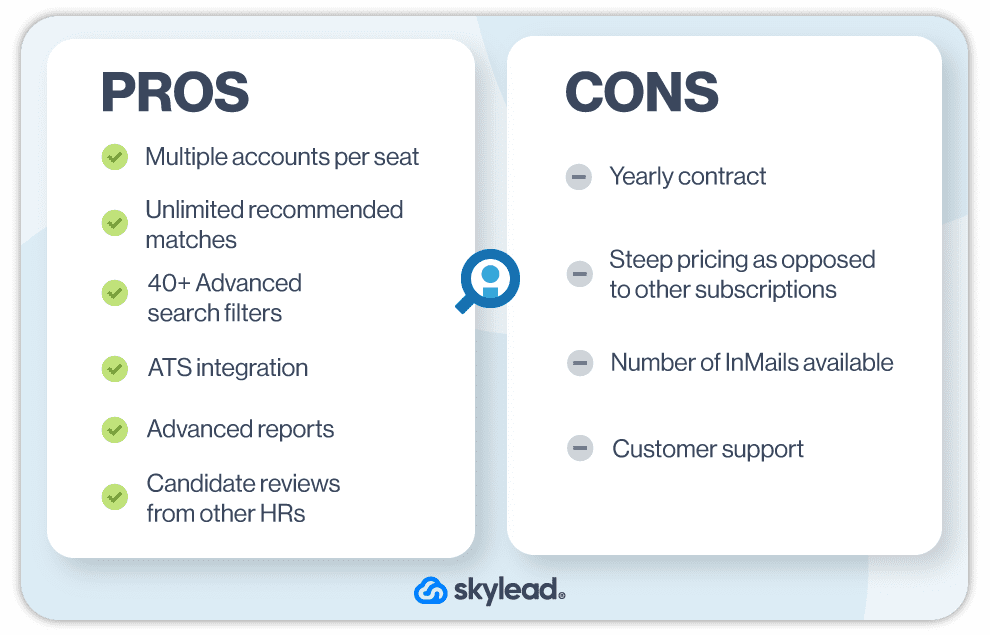
LinkedIn subscription summary
LinkedIn is indeed the best choice for your recruiting efforts (e.g. generating leads on LinkedIn, outreaching candidates...). Why? Since people tend to update their profiles more regularly, unlike their job boards or candidates' profiles in the company system. There is no doubt about that.
However, choosing the right LinkedIn subscription for recruiting can be tricky in the long run. Besides, it depends entirely on your and the company’s needs. If, for example, your hiring needs are constant, and you have an entire team of HRs, you should think about choosing the true Recruiter subscription. On the other hand, if you are a stand-alone recruiter and have little to no hiring needs, then Premium Business will do just the work.
Lastly, if you have consistent hiring needs but are willing to sacrifice all those showstopper features, you can subscribe to Recruiter Lite. It truly has some constraints, but it is more than an upgrade from Premium Business.
And just a reminder: you can try out any LinkedIn subscription free for a month. This way, you can decide which option best suits your needs.
Nonetheless, if you are the hiring manager who wishes to use either Premium Business, Recruiter Lite, or Recruiter itself for your hiring process, then you should know one last thing. There is a way that you can use to improve your candidates' outreach experience and streamline your work, and it is called Skylead.
To clarify, it will help you outreach your target candidates on autopilot and let you focus more on your interviews. Be sure to check out how to create a Skylead outreach campaign.
If you wish to use Skylead to outreach your candidates and add personalization, come by and try out Skylead for free. We would be happy to see you 🙂
